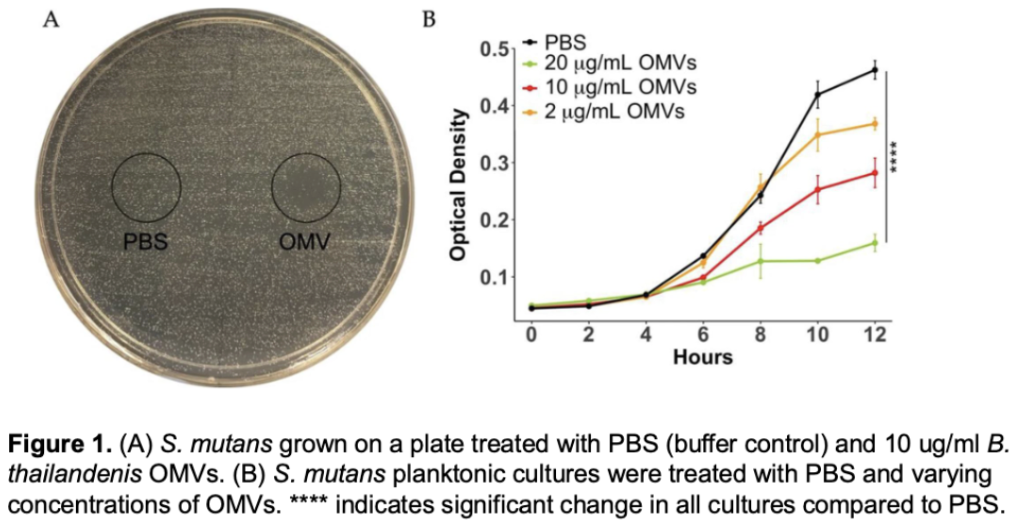chapter 10.1 case study, inhibition of Streptococcus mutans biofilms with bacterial- derived outer membrane vesicles
1/6
There's no tags or description
Looks like no tags are added yet.
Name | Mastery | Learn | Test | Matching | Spaced |
|---|
No study sessions yet.
7 Terms
Aim:
determine if OMVs made by Burkholderia thailandensis can inhibit planktonic growth and biofilm, formation of Streptococcus mutans
Hypothesis:
B. thailandensis OMVs possess antimicrobial and antibiofilm activity against S. mutans.
background
Biofilms: complex environments of bacteria and other microbes that require cooperation and communication.
Outer membrane vesicles: small lipid- enclosed packages that bud off from bacterial membranes. They can contain DNA/ RNA, proteins, antimicrobial compounds, and more. They bind to and fuse with the surfaces of other cells, delivering their contents into the other cell. They are used as a defense strategy to compete with other bacteria. They help interbacterial communication. OMVs can protect the extracellular matrix, it can also disrupt other bacterial biofilms. Gram -ve bacteria can shed OMVs in response to environmental stressors. The vesicles contain small molecules, proteins, lipids, polysaccharides, RNA/DNA. B. thailandenis OMWs possess antimicrobial compounds (peptidoglycan hydrolases HMNQ) and long chain rhamnolipids

step 1:
a. Left
S. mutans grown
Treated with PBS: phosphate buffer saline: salt water with phosphate in it
A. right
S. mutans grown
Treated with OMV: outer membrane vesicles with antimicrobial cmp from B. thai
In circle, there is a zone of inhibition, where treatment was put onto the plate
B.
Treatment is NOT added to a plate, it is added into a liquid culture where S. mutans were inoculated. This medium does not have any nutrients
Why did they present this as their first piece of data?
Show that OMV antimicrobial activity can be held on solid and liquid media
Confirms that OMVs do kill
What does this data mean? Are the data in the two panels redundant?
A. growth on solid media, killing cells after they are grown
B. inhibition of growth, preventing them from growing
These graphs are NOT talking ab biofilm formation, colonies are not the same as biofilm

step 1: Wanted to look at anti-biofilm activity (Cultures were already grown before the experiment)
Against which of the following lifestyles are Burkholderia OMVs effective antimicrobials
recall/ asterisks: indicate statistical significance in data comparisons. (*, p<0.05, statistically significant) (**, p<0.01, highly significant) (***, p<0.001, very highly significant)
Both biofilm and planktonic growth. OMVs inhibit both
In which lifestyle are OMVs more effective than gentamicin in reducing bacterial growth?
Both
Look @ brackets
step 2:
conclusions
B. thailandenis OMVs are effective antimicrobials against planktonic and biofilm S. mutans
The OMVs reduce biofilm cell density, potentially by increasing cell death and reducing biofilm thickness
Recall. Hypothesis: B. thailandensis OMVs possess antimicrobial and antibiofilm activity against S. mutans. Accept or reject???